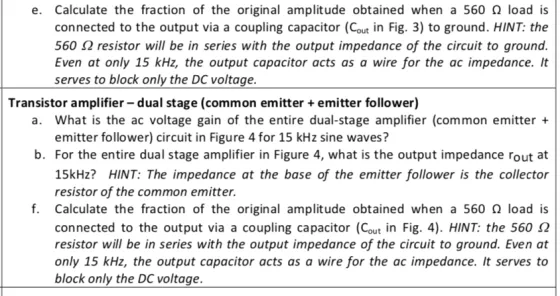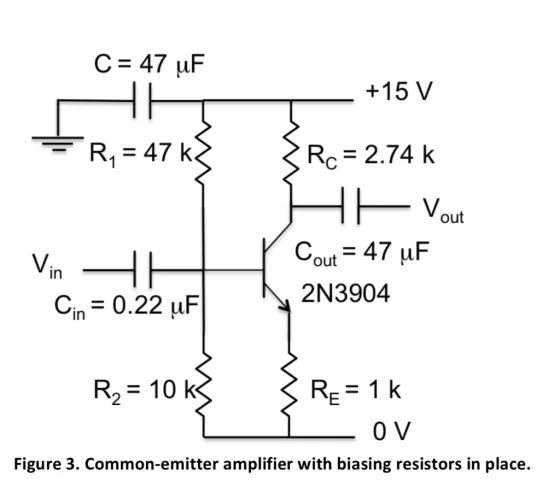Answered step by step
Verified Expert Solution
Question
1 Approved Answer
Calculate the fraction of the original amplitude obtained when a 560 load is connected to the output via a coupling capacitor (Cout in Fig.


Calculate the fraction of the original amplitude obtained when a 560 load is connected to the output via a coupling capacitor (Cout in Fig. 3) to ground. HINT: the 5602 resistor will be in series with the output impedance of the circuit to ground. Even at only 15 kHz, the output capacitor acts as a wire for the ac impedance. It serves to block only the DC voltage. Transistor amplifier-dual stage (common emitter + emitter follower) a. What is the ac voltage gain of the entire dual-stage amplifier (common emitter + emitter follower) circuit in Figure 4 for 15 kHz sine waves? b. For the entire dual stage amplifier in Figure 4, what is the output impedance rout at 15kHz? HINT: The impedance at the base of the emitter follower is the collector resistor of the common emitter. f. Calculate the fraction of the original amplitude obtained when a 560 load is connected to the output via a coupling capacitor (Cout in Fig. 4). HINT: the 560 2 resistor will be in series with the output impedance of the circuit to ground. Even at only 15 kHz, the output capacitor acts as a wire for the ac impedance. It serves to block only the DC voltage. Vin C = 47 F R = 47 K H Cin = 0.22 F R = 10 k +15 V Rc = 2.74 k it Vout Cout= 47 uF 2N3904 RE=1 k OV Figure 3. Common-emitter amplifier with biasing resistors in place.
Step by Step Solution
★★★★★
3.31 Rating (145 Votes )
There are 3 Steps involved in it
Step: 1
Thanks for providing the values Lets proceed with the calculations First we need to find the output impedance of the emitter follower stage Zemitterfo...
Get Instant Access to Expert-Tailored Solutions
See step-by-step solutions with expert insights and AI powered tools for academic success
Step: 2

Step: 3

Ace Your Homework with AI
Get the answers you need in no time with our AI-driven, step-by-step assistance
Get Started


